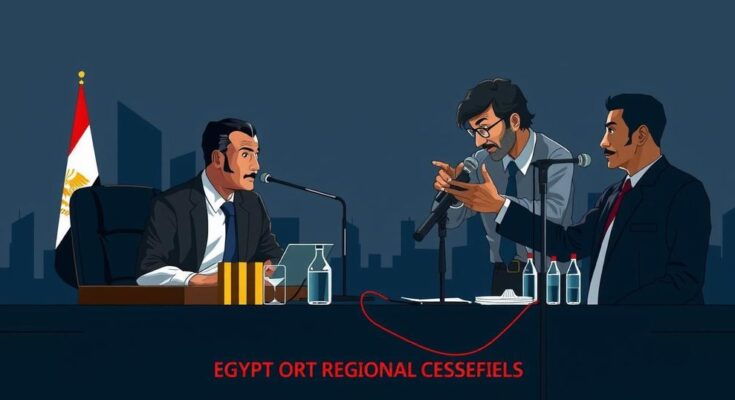U.S. officials are in Egypt and Israel to negotiate ceasefires in Gaza and Lebanon amidst ongoing violence, following a series of diplomatic efforts this year. CIA chief William Burns and envoys Brett McGurk and Amos Hochstein are involved in discussions, aiming to facilitate agreements on hostages and military withdrawals. High casualty figures underscore the urgency for a resolution, particularly in light of the notorious humanitarian situation in both regions, stemming from escalated hostilities since October 2023.
Senior officials from the United States have arrived in Israel and Egypt as part of diplomatic efforts to facilitate ceasefires in Gaza and Lebanon. CIA Director William Burns held discussions with Egyptian President Abdel Fattah El Sisi in Cairo, focusing on establishing a ceasefire in Gaza and a potential hostages-for-prisoners agreement involving Israel and Hamas. U.S. envoys Brett McGurk and Amos Hochstein have also been dispatched, with Mr. McGurk addressing the situation in Gaza and Mr. Hochstein targeting the Lebanon conflict, following reports of a potential agreement aimed at halting hostilities between Israel and Hezbollah, a group backed by Iran. The White House Press Secretary, Karine Jean-Pierre, informed reporters that McGurk and Hochstein will engage on various critical issues, including those pertaining to hostages, Iran, and cross-border matters. This visit follows a series of diplomatic initiatives over the year by the U.S., alongside Egypt and Qatar, to mediate peace talks between the warring factions. Notably, U.S. Secretary of State Antony Blinken has undertaken numerous visits to the region, with this being observably significant as the U.S. elections approach. An end to hostilities in Lebanon appears closer compared to the protracted situation in Gaza, which escalated after the October 7, 2023, attack by Hamas that resulted in approximately 1,200 Israeli casualties and the capture of 251 individuals. In retaliation, Hezbollah commenced attacks from Lebanon in solidarity with Hamas, initiating a cycle of violence that has persisted for nearly a year, culminating in Israel’s ground invasion of southern Lebanon, intensifying destruction in the region. The reported U.S.-proposed ceasefire would entail a temporary 60-day cessation of hostilities, permitting the Lebanese army to deploy and displace Hezbollah forces along the Litani River front area, while Israel would be expected to withdraw from southern Lebanon within a specified time frame. Critical to this proposal is the anticipation of a Monitoring and Enforcement Mechanism established by Lebanon, the U.S., Israel, and others to ensure adherence to the terms of the ceasefire. Lebanon’s caretaker Prime Minister Najib Mikati expressed optimism regarding impending ceasefire discussions with Israel. However, skepticism remains regarding both parties’ willingness to accept the outlined proposal, particularly for Israel, which seeks assurances for self-defense against possible violations by Hezbollah. Furthermore, the situation in Gaza continues to be dire, as recent ceasefire negotiations in Doha yielded no concrete outcomes. Former Israeli hostage negotiator Gershon Baskin emphasized, “Netanyahu needs to understand: there is no deal that returns all the hostages without ending the war. Hamas needs to understand: there is no end to the war as long as Hamas continues to rule Gaza,” accentuating the complexity of the ongoing conflict.
The article discusses the current diplomatic efforts by U.S. officials to achieve ceasefires in the ongoing conflicts in Gaza and Lebanon, particularly through negotiations involving Israel, Egypt, and various regional actors. It establishes the context of the protracted conflicts that have resulted from the Hamas attack on Israel and consecutive retaliatory actions by Hezbollah, highlighting the present humanitarian crisis and the high casualty figures. It also examines the historical attempts for peace, referencing U.N. Resolution 1701, which sought to curb hostilities but has seen inadequate implementation since its inception after the 2006 war.
In summary, the mission undertaken by U.S. diplomats to negotiate ceasefires in Gaza and Lebanon represents a crucial, albeit challenging effort to alleviate significant humanitarian crises caused by extensive violence in these regions. The proposed measures to withdraw military forces and implement monitoring systems seek to stabilize the situation, while the ongoing talks reflect an urgent need for a diplomatic resolution to the mounting conflicts. The complexities introduced by political dynamics within the involved nations will significantly influence the feasibility of achieving a lasting peace.
Original Source: www.thenationalnews.com




